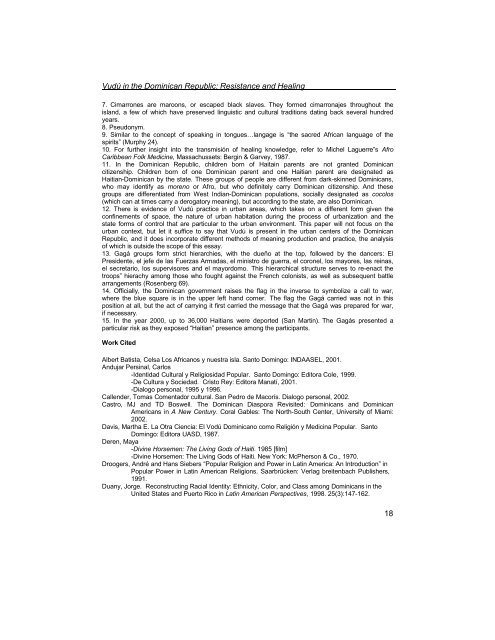Vudu in the Dominican Republic
by Ana-Maurine Lara
by Ana-Maurine Lara
You also want an ePaper? Increase the reach of your titles
YUMPU automatically turns print PDFs into web optimized ePapers that Google loves.
Vudú <strong>in</strong> <strong>the</strong> Dom<strong>in</strong>ican <strong>Republic</strong>: Resistance and Heal<strong>in</strong>g<br />
7. Cimarrones are maroons, or escaped black slaves. They formed cimarronajes throughout <strong>the</strong><br />
island, a few of which have preserved l<strong>in</strong>guistic and cultural traditions dat<strong>in</strong>g back several hundred<br />
years.<br />
8. Pseudonym.<br />
9. Similar to <strong>the</strong> concept of speak<strong>in</strong>g <strong>in</strong> tongues…langage is “<strong>the</strong> sacred African language of <strong>the</strong><br />
spirits” (Murphy 24).<br />
10. For fur<strong>the</strong>r <strong>in</strong>sight <strong>in</strong>to <strong>the</strong> transmisión of heal<strong>in</strong>g knowledge, refer to Michel Laguerre‟s Afro<br />
Caribbean Folk Medic<strong>in</strong>e, Massachussets: Berg<strong>in</strong> & Garvey, 1987.<br />
11. In <strong>the</strong> Dom<strong>in</strong>ican <strong>Republic</strong>, children born of Haita<strong>in</strong> parents are not granted Dom<strong>in</strong>ican<br />
citizenship. Children born of one Dom<strong>in</strong>ican parent and one Haitian parent are designated as<br />
Haitian-Dom<strong>in</strong>ican by <strong>the</strong> state. These groups of people are different from dark-sk<strong>in</strong>ned Dom<strong>in</strong>icans,<br />
who may identify as moreno or Afro, but who def<strong>in</strong>itely carry Dom<strong>in</strong>ican citizenship. And <strong>the</strong>se<br />
groups are differentiated from West Indian-Dom<strong>in</strong>ican populations, socially designated as cocolos<br />
(which can at times carry a derogatory mean<strong>in</strong>g), but accord<strong>in</strong>g to <strong>the</strong> state, are also Dom<strong>in</strong>ican.<br />
12. There is evidence of Vudú practice <strong>in</strong> urban areas, which takes on a different form given <strong>the</strong><br />
conf<strong>in</strong>ements of space, <strong>the</strong> nature of urban habitation dur<strong>in</strong>g <strong>the</strong> process of urbanization and <strong>the</strong><br />
state forms of control that are particular to <strong>the</strong> urban environment. This paper will not focus on <strong>the</strong><br />
urban context, but let it suffice to say that Vudú is present <strong>in</strong> <strong>the</strong> urban centers of <strong>the</strong> Dom<strong>in</strong>ican<br />
<strong>Republic</strong>, and it does <strong>in</strong>corporate different methods of mean<strong>in</strong>g production and practice, <strong>the</strong> analysis<br />
of which is outside <strong>the</strong> scope of this essay.<br />
13. Gagá groups form strict hierarchies, with <strong>the</strong> dueño at <strong>the</strong> top, followed by <strong>the</strong> dancers: El<br />
Presidente, el jefe de las Fuerzas Armadas, el m<strong>in</strong>istro de guerra, el coronel, los mayores, las re<strong>in</strong>as,<br />
el secretario, los supervisores and el mayordomo. This hierarchical structure serves to re-enact <strong>the</strong><br />
troops‟ hierachy among those who fought aga<strong>in</strong>st <strong>the</strong> French colonists, as well as subsequent battle<br />
arrangements (Rosenberg 69).<br />
14. Officially, <strong>the</strong> Dom<strong>in</strong>ican government raises <strong>the</strong> flag <strong>in</strong> <strong>the</strong> <strong>in</strong>verse to symbolize a call to war,<br />
where <strong>the</strong> blue square is <strong>in</strong> <strong>the</strong> upper left hand corner. The flag <strong>the</strong> Gagá carried was not <strong>in</strong> this<br />
position at all, but <strong>the</strong> act of carry<strong>in</strong>g it first carried <strong>the</strong> message that <strong>the</strong> Gagá was prepared for war,<br />
if necessary.<br />
15. In <strong>the</strong> year 2000, up to 36,000 Haitians were deported (San Mart<strong>in</strong>). The Gagás presented a<br />
particular risk as <strong>the</strong>y exposed “Haitian” presence among <strong>the</strong> participants.<br />
Work Cited<br />
Albert Batista, Celsa Los Africanos y nuestra isla. Santo Dom<strong>in</strong>go: INDAASEL, 2001.<br />
Andujar Pers<strong>in</strong>al, Carlos<br />
-Identidad Cultural y Religiosidad Popular. Santo Dom<strong>in</strong>go: Editora Cole, 1999.<br />
-De Cultura y Sociedad. Cristo Rey: Editora Manatí, 2001.<br />
-Dialogo personal, 1995 y 1996.<br />
Callender, Tomas Comentador cultural. San Pedro de Macorís. Dialogo personal, 2002.<br />
Castro, MJ and TD Boswell. The Dom<strong>in</strong>ican Diaspora Revisited: Dom<strong>in</strong>icans and Dom<strong>in</strong>ican<br />
Americans <strong>in</strong> A New Century. Coral Gables: The North-South Center, University of Miami:<br />
2002.<br />
Davis, Martha E. La Otra Ciencia: El Vodú Dom<strong>in</strong>icano como Religión y Medic<strong>in</strong>a Popular. Santo<br />
Dom<strong>in</strong>go: Editora UASD, 1987.<br />
Deren, Maya<br />
-Div<strong>in</strong>e Horsemen: The Liv<strong>in</strong>g Gods of Haiti. 1985 [film]<br />
-Div<strong>in</strong>e Horsemen: The Liv<strong>in</strong>g Gods of Haiti. New York: McPherson & Co., 1970.<br />
Droogers, André and Hans Siebers “Popular Religion and Power <strong>in</strong> Lat<strong>in</strong> America: An Introduction” <strong>in</strong><br />
Popular Power <strong>in</strong> Lat<strong>in</strong> American Religions. Saarbrücken: Verlag breitenbach Publishers,<br />
1991.<br />
Duany, Jorge. Reconstruct<strong>in</strong>g Racial Identity: Ethnicity, Color, and Class among Dom<strong>in</strong>icans <strong>in</strong> <strong>the</strong><br />
United States and Puerto Rico <strong>in</strong> Lat<strong>in</strong> American Perspectives, 1998. 25(3):147-162.<br />
18

















